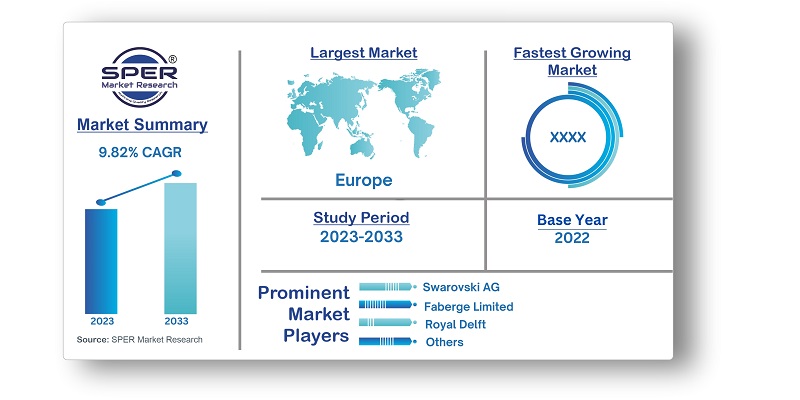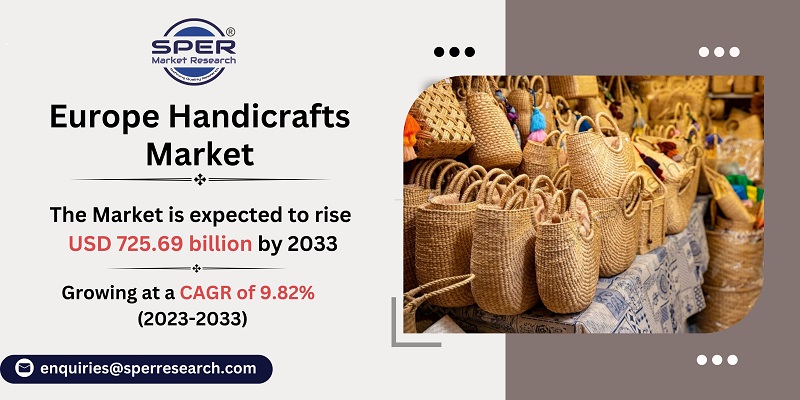
Europe Handicrafts Market Growth, Size, Trends, Revenue, Share, Demand and Future Competition
Europe Handicrafts Market Size- By Type, By Application, By Distribution Channel- Regional Outlook, Competitive Strategies and Segment Forecast to 2033
| Published: Nov-2023 | Report ID: FMCG23133 | Pages: 1 - 154 | Formats*: |
| Category : Consumer & Retail | |||
- Technology integration: To improve their marketing, client reach, and production, artisans are utilising technology. They are connecting with a global audience and showcasing their products using digital marketing methods, e-commerce websites, and social media channels.
- Partnerships and collaborations: In order to develop distinctive collections and exclusive alliances, artisans are working in tandem with designers and companies. These kinds of partnerships give craftspeople access to new markets, exposure to other consumer groups, and chances for creativity.


| Report Metric | Details |
| Market size available for years | 2019-2033 |
| Base year considered | 2022 |
| Forecast period | 2023-2033 |
| Segments covered | By Type, By Application, By Distribution Channel |
| Regions covered | France, Germany, Italy, Spain, United Kingdom, Others |
| Companies Covered | Swarovski AG, Faberge Limited, Royal Delft, Wedgwood (Fiskars Group), Goebel Porzellanmanufaktur GmbH, Lalique, Herend Porcelain Manufactory Ltd., Murano Glass, Meissen Porcelain Manufactory, Royal Copenhagen, Others |
- Artisans and Craftsmen
- Corporate Gifting and Promotions
- Cultural and Heritage Organizations
- Homeowners and decorators looking for artisanal pieces to enhance their living spaces.
- Individuals interested in unique, handmade products for personal use or as gifts.
- Tourists
- Others
| By Type: |
|
| By Application: |
|
| By Distribution Channel: |
|
- Europe Handicrafts Market Size (FY’2023-FY’2033)
- Overview of Europe Handicrafts Market
- Segmentation of Europe Handicrafts Market By Type (Artmetal Ware, Attars and Agarbattis, Embroidered and Crocheted Goods, Handprinted Textiles and Scarves, Imitation Jewelry, Pottery and Glass wares, Sculptures, Woodware, Zari and Zari Goods, Others)
- Segmentation of Europe Handicrafts Market By Application (Commercial, Residential)
- Segmentation of Europe Handicrafts Market By Distribution Channel (Departmental Stores, Independent Retailers, Mass Retailers, Online Stores, Specialty Stores, Others)
- Statistical Snap of Europe Handicrafts Market
- Expansion Analysis of Europe Handicrafts Market
- Problems and Obstacles in Europe Handicrafts Market
- Competitive Landscape in the Europe Handicrafts Market
- Impact of COVID-19 and Demonetization on Europe Handicrafts Market
- Details on Current Investment in Europe Handicrafts Market
- Competitive Analysis of Europe Handicrafts Market
- Prominent Players in the Europe Handicrafts Market
- SWOT Analysis of Europe Handicrafts Market
- Europe Handicrafts Market Future Outlook and Projections (FY’2023-FY’2033)
- Recommendations from Analyst
1.1. Scope of the report1.2. Market segment analysis
2.1. Research data source2.1.1. Secondary Data2.1.2. Primary Data2.1.3. SPER’s internal database2.1.4. Premium insight from KOL’s2.2. Market size estimation2.2.1. Top-down and Bottom-up approach2.3. Data triangulation
4.1. Driver, Restraint, Opportunity and Challenges analysis4.1.1. Drivers4.1.2. Restraints4.1.3. Opportunities4.1.4. Challenges4.2. COVID-19 Impacts of the Europe Handicrafts Market
5.1. SWOT Analysis5.1.1. Strengths5.1.2. Weaknesses5.1.3. Opportunities5.1.4. Threats5.2. PESTEL Analysis5.2.1. Political Landscape5.2.2. Economic Landscape5.2.3. Social Landscape5.2.4. Technological Landscape5.2.5. Environmental Landscape5.2.6. Legal Landscape5.3. PORTER’s Five Forces5.3.1. Bargaining power of suppliers5.3.2. Bargaining power of buyers5.3.3. Threat of Substitute5.3.4. Threat of new entrant5.3.5. Competitive rivalry5.4. Heat Map Analysis
6.1. Europe Handicrafts Market Manufacturing Base Distribution, Sales Area, Product Type6.2. Mergers & Acquisitions, Partnerships, Product Launch, and Collaboration in Europe Handicrafts Market
7.1. Europe Handicrafts Market Value Share and Forecast, By Type, 2023-20337.2. Artmetal Ware7.3. Attars and Agarbattis7.4. Embroidered and Crocheted Goods7.5. Handprinted Textiles and Scarves7.6. Imitation Jewelry7.7. Pottery and Glass wares7.8. Sculptures7.9. Woodware7.10. Zari and Zari Goods7.11. Others
8.1. Europe Handicrafts Market Value Share and Forecast, By Application, 2023-20338.2. Commercial8.3. Residential
9.1. Europe Handicrafts Market Value Share and Forecast, By Distribution Channel, 2023-20339.2. Departmental Stores9.3. Independent Retailers9.4. Mass Retailers9.5. Online Stores9.6. Specialty Stores9.7. Others
10.1. Europe Handicrafts Market Size and Market Share
11.1. Europe Handicrafts Market Size and Market Share By Type (2019-2026)11.2. Europe Handicrafts Market Size and Market Share By Type (2027-2033)
12.1. Europe Handicrafts Market Size and Market Share By Application (2019-2026)12.2. Europe Handicrafts Market Size and Market Share By Application (2027-2033)
13.1. Europe Handicrafts Market Size and Market Share By Distribution Channel (2019-2026)13.2. Europe Handicrafts Market Size and Market Share By Distribution Channel (2027-2033)
14.1. Europe Handicrafts Market Size and Market Share By Region (2019-2026)14.2. Europe Handicrafts Market Size and Market Share By Region (2027-2033)14.3. France14.4. Germany14.5. Italy14.6. Spain14.7. United Kingdom14.8. Others
15.1. Faberge Limited15.1.1. Company details15.1.2. Financial outlook15.1.3. Product summary15.1.4. Recent developments15.2. Goebel Porzellanmanufaktur GmbH15.2.1. Company details15.2.2. Financial outlook15.2.3. Product summary15.2.4. Recent developments15.3. Herend Porcelain Manufactory Ltd.15.3.1. Company details15.3.2. Financial outlook15.3.3. Product summary15.3.4. Recent developments15.4. Lalique15.4.1. Company details15.4.2. Financial outlook15.4.3. Product summary15.4.4. Recent developments15.5. Meissen Porcelain Manufactory15.5.1. Company details15.5.2. Financial outlook15.5.3. Product summary15.5.4. Recent developments15.6. Murano Glass15.6.1. Company details15.6.2. Financial outlook15.6.3. Product summary15.6.4. Recent developments15.7. Royal Copenhagen15.7.1. Company details15.7.2. Financial outlook15.7.3. Product summary15.7.4. Recent developments15.8. Royal Delft15.8.1. Company details15.8.2. Financial outlook15.8.3. Product summary15.8.4. Recent developments15.9. Swarovski AG15.9.1. Company details15.9.2. Financial outlook15.9.3. Product summary15.9.4. Recent developments15.10. Wedgwood (Fiskars Group)15.10.1. Company details15.10.2. Financial outlook15.10.3. Product summary15.10.4. Recent developments15.11. Others
SPER Market Research’s methodology uses great emphasis on primary research to ensure that the market intelligence insights are up to date, reliable and accurate. Primary interviews are done with players involved in each phase of a supply chain to analyze the market forecasting. The secondary research method is used to help you fully understand how the future markets and the spending patterns look likes.
The report is based on in-depth qualitative and quantitative analysis of the Product Market. The quantitative analysis involves the application of various projection and sampling techniques. The qualitative analysis involves primary interviews, surveys, and vendor briefings. The data gathered as a result of these processes are validated through experts opinion. Our research methodology entails an ideal mixture of primary and secondary initiatives.



Frequently Asked Questions About This Report
PLACE AN ORDER
Year End Discount
Sample Report
Pre-Purchase Inquiry
NEED CUSTOMIZATION?
Request CustomizationCALL OR EMAIL US
100% Secure Payment






Related Reports
Our Global Clients
Our data-driven insights have influenced the strategy of 200+ reputed companies across the globe.




















